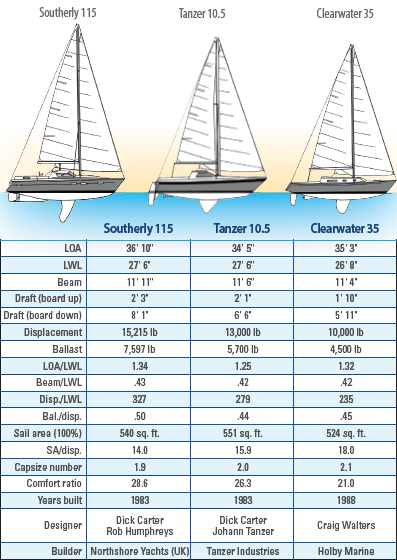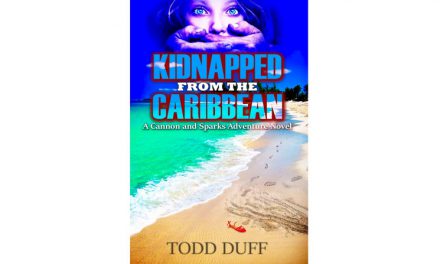
. . . and two true centerboarders
It is often said that all boats are compromises, but that is especially true with regard to cruising center-boarders when it comes to deciding how much the centerboard box should be allowed to intrude into the interior accommodations. Another factor is whether the builder wants to offer the centerboard configuration as an option on an existing production boat designed originally with a deeper keel. Invariably, the board does not obstruct the interior but resides below the cabin sole in a stub keel that also contains the majority of the ballast. The resulting boat is not really a true centerboarder but a compromise keel/centerboarder. The draft is only partially reduced, and the combination of two markedly different foils is not the best combination for aerodynamic efficiency. The absolute minimum draft can only be achieved by retracting the foil completely into the hull or “canoe body.”
It’s no secret that I like center- boarders. I even own one, our C&C Corvette, Trillium IV. I like the shoal draft they offer, and from my days racing and designing International 14s, I’m comfortable with the center-board or daggerboard concept. It’s refreshing, therefore, to look at three true centerboarders, where the entire foil is housed in the hull so that the minimum draft is that of the canoe body and the resulting efficiency of the foil is not compromised by a stub keel. The featured Southerly 115 and the Tanzer 10.5 are from the always innovative Dick Carter, while the Clearwater 35 is from Craig Walters, who, like so many other talented designers, started his career in the Carter design office.
I should also say that, even though I’m referring to these boats as centerboarders, they are probably more accurately described as having lift keels. That is certainly the case for the Southerly, where the centerboard, which weighs about 2,500 pounds, accounts for more than 30 percent of the entire ballast.
It is also interesting to see how each boat addresses the problem of what to do with the rudder when the keel is completely retracted, since the rudder cannot be deeper than the canoe body if that minimum draft is to be achieved. The version of the 115 reviewed is a later Mk IV model modified by Rob Humphreys to incorporate twin shoal- draft fixed rudders, while the Tanzer’s rudder retracts up the transom on a small fixed skeg, and the Clearwater’s rudder pivots aft to reduce draft. The goal, of course, is to still have enough rudder in the water to steer the boat effectively when the keel and rudders are completely retracted.
The other trade-off with a center- boarder is that, in order to achieve the minimum draft of the canoe body, the majority of the ballast is housed in the bilge, not in a deep fixed keel. This results in a significantly higher center of gravity, with a resulting reduction of sailing stability. In almost all cases, shoal-draft boats are given more beam to compensate for the higher CG by increasing form stability. We see this with all three of our chosen boats having beam/LWL ratios over 40 percent. To further increase stability, all three of the boats have large amounts of ballast, resulting in ballast/displacement (B/D) ratios higher than 40 percent in the Tanzer and the Clearwater and a whopping 50 percent in the Southerly.
Although not visible on our drawings, it is also interesting to see how each designer addressed the challenge of the centerboard box intruding into the interior. The Southerly and the Tanzer, coming from the same designer, incorporate the same solution of having the box form the end of the galley and the dinette. In the Clearwater, on the other hand, the whole interior is structured around the box.
If we can trust what the numbers tell us about relative performance, the Clearwater 35 excels with the lowest displacement/LWL (D/L) ratio of 235, compared to 279 for the Tanzer and a hefty 327 for the Southerly. The Clearwater also has the highest sail area/displacement ratio (SA/D) of a very competitive 18, compared to a more normal 15.9 for the Tanzer and a conservative 14 for the Southerly. However, with its lighter displacement, even with a 45 percent B/D ratio, the Clearwater will be reefing earlier, while the Southerly, with its smaller sail plan, higher B/D ratio, and greater displacement, will be standing up well when the wind gets stronger.
The capsize numbers reflect the wide beams of all three boats, but the lighter displacements of the Clearwater and the Tanzer give them values of 2.1 and 2.0 respectively. Capsize numbers above 2 are a concern for offshore sailing. Although it is slightly beamier, the Southerly comes in at a more conservative 1.9, primarily due to its higher displacement, which, at 15,215 pounds, is a full 50 percent greater than the Clearwater’s.
These boats present three very interesting approaches to the true centerboard concept, achieving absolutely minimum draft for shoal-water cruising by means of lift keels retracted into the canoe body of the hull. From my perspective, the Clearwater is the prettiest of the three, but its interior layout is the most compromised.





